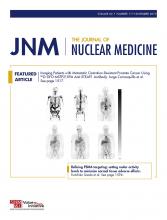Discussions with leaders: JNM editor in chief, Johannes Czernin, MD, conducts an interview with Uwe Haberkorn, MD, PhD, from the University of Heidelberg and German Cancer Research Center, on his widely recognized work in diagnostic, therapeutic, and theranostic nuclear medicine.
Page 1495
NRC patient release draft: Siegel looks at the history and current proposed revisions of the Nuclear Regulatory Commission’s guidelines on release of patients administered radioactive material.
Page 1499
131I in hyperthyroidism: Greenspan and colleagues provide a detailed commentary on and summarize major flaws of a recent article indicating an association between radioactive iodine treatment in hyperthyroidism and increased risk of death from solid cancers.
Page 1500
131I therapy and cancer mortality: Chen and Dilsizian take a critical look at a recent article suggesting that radioactive iodine treatment is associated with increased cancer mortality in patients with hyperthyroidism.
Page 1502
VISION and the future of theranostics: Rahbar and colleagues offer perspective on the VISION trial, the first international, randomized study assessing overall survival after 177Lu–prostate-specific membrane antigen–617 treatment for advanced-stage prostate cancer.
Page 1504
Quantitative clinical nuclear cardiology: Garcia and colleagues provide the first of 2 educational articles on nuclear cardiology, here describing the many clinically established quantitative applications and tools.
Page 1507
89Zr–anti-STEAP1 PET imaging: Carrasquillo and colleagues determine the ability of PET/CT with this antibody, which recognizes the 6-transmembrane epithelial antigen of prostate-1, to detect lesions in patients with metastatic castration-resistant prostate cancer.
Page 1517
PET/CT and THTF in prostate cancer: Jadvar and colleagues assess the relationship of 18F-FDG PET/CT findings to time to hormonal treatment failure in men with metastatic castration-sensitive prostate cancer.
Page 1524
18F-Fluciclovine–targeted prostate biopsy: Abiodun-Ojo and colleagues detail 18F-fluciclovine uptake parameters that correlate with true positivity for local recurrence in non–prostatectomy-treated prostate cancer patients.
Page 1531
PET/MRI for ILP treatment response: Grueneisen and colleagues explore the diagnostic potential of simultaneously acquired 18F-FDG PET and MRI data sets for therapy response assessment of isolated limb perfusion in patients with soft-tissue sarcomas.
Page 1537
The dark side of radiomics: Buvat and Orlhac provide perspective on the proliferation of radiomic-related publications on PET imaging and emphasize the importance of dissemination of negative as well as positive results.
Page 1543
18F-FDG PET/CT and BRAFV600 in melanoma: Saadani and colleagues correlate and predict B-rapidly accelerated fibrosarcoma valine 600 mutation status with both conventional and radiomics 18F-FDG PET/CT features, and explore several methods of feature selection in melanoma radiomics.
Page 1545
PET/CT in esophageal cancer: Valkema and colleagues prospectively investigate optimal evaluation of qualitative and quantitative 18F-FDG PET/CT in esophageal cancer response assessments 12–14 weeks after neoadjuvant chemoradiotherapy.
Page 1553
PET and bevacizumab outcome prediction: Avallone and colleagues assess 18F-FDG PET/CT performed during and after preoperative bevacizumab chemoradiotherapy for prediction of complete pathologic tumor regression and survival in patients with MRI-defined high-risk locally advanced rectal cancer.
Page 1560
Modulating HER2 for pretargeted imaging: Pereira and colleagues explore in both in vitro and in vivo studies the modulation of HER2 endocytosis to improve pertuzumab uptake in HER2-positive gastric tumors to allow the use of a pretargeted imaging approach.
Page 1569
Single functioning kidney and PRLT: Zhang and colleagues explore the safety, tolerability, renal function effects, and therapeutic efficacy of prostate-specific membrane antigen–targeted radioligand therapy using 177Lu-labeled PSMA-617 in metastatic castration-resistant prostate cancer patients with a single functioning kidney.
Page 1579
18F-DCFPyL PET/CT in prostate cancer: Rousseau and colleagues investigate the safety, sensitivity, and impact on patient management of this prostate-specific membrane antigen–targeting radiotracer in the setting of biochemical recurrence of prostate cancer.
Page 1587
18F-PSMA-1007 uptake with different MA: Soeda and colleagues describe changes in the whole-body distribution of 18F–prostate-specific membrane antigen–1007 when using solutions with different peptide concentrations in mice studies.
Page 1594
rA1M as kidney protector during PRRT: Andersson and colleagues report on the effect of a recombinant form of α1-microglobulin on in vivo biokinetics of 177Lu-octreotate and therapeutic response in tumor tissue after 177Lu-octreotate peptide-receptor radionuclide therapy.
Page 1600
Dual–time-point 18F-FCH PET/CT: Broos and colleagues look at optimal timing of dual–time-point 18F-fluorocholine parathyroid PET/CT for preoperative identification of hyperfunctioning parathyroid glands.
Page 1605
Longitudinal tau PET in AD: Cho and colleagues document changes after 2 years in cortical tau accumulation and association with cognitive decline in Alzheimer disease as assessed with 18F-flortaucipir PET, MRI, and neuropsychologic testing.
Page 1611
Preclinical characterization of NM600: Grudzinski and colleagues characterize the in vivo biodistribution and tumor selectivity of 86Y-NM600, a theranostic alkylphosphocholine radiometal chelate with broad tumor selectivity, in a variety of preclinical cancer models.
Page 1622
PET/CT in acute lung injury: Braune and colleagues ask whether static 18F-FDG PET/CT and SUV analysis might be an alternative to dynamic 18F-FDG PET/CT and Patlak analysis for quantification of pulmonary inflammation in experimental acute respiratory distress syndrome.
Page 1629
Selective blocking of exocrine GLP-1R: Khera and colleagues present a novel approach of using exendin conjugates to improve the specificity of imaging β-cells to quantify total β-cell mass, despite the expression of glucagonlike peptide-1 receptors on exocrine pancreas.
Page 1635
Improving scatter correction in prostate PET/MRI: Lindemann and colleagues report on a study of the impact of unrenormalized absolute scatter correction on 68Ga–prostate-specific membrane antigen PET quantification in PET/MR imaging of the prostate.
Page 1642
Joint reconstruction in brain data: Rezaei and colleagues describe a quantitative evaluation and validation of joint activity and attenuation reconstruction from time-of-flight PET emission data in PET/MR brain imaging.
Page 1649
- © 2019 by the Society of Nuclear Medicine and Molecular Imaging.







